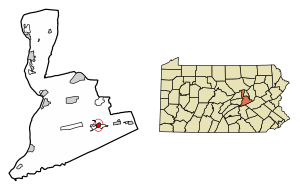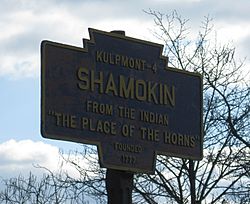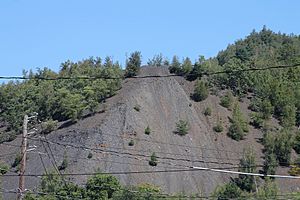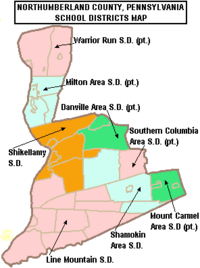Shamokin, Pennsylvania facts for kids
Quick facts for kids
Shamokin, Pennsylvania
|
||
|---|---|---|
|
City
|
||
|
||

Location of City of Shamokin and adjacent Coal Township in Northumberland County, Pennsylvania.
|
||
| Country | United States | |
| State | Pennsylvania | |
| County | Northumberland | |
| Settled | 1835 | |
| Incorporated (borough) | 1864 | |
| Incorporated (city) | 1949 | |
| Government | ||
| • Type | City | |
| Area | ||
| • Total | 0.83 sq mi (2.16 km2) | |
| • Land | 0.83 sq mi (2.16 km2) | |
| • Water | 0.00 sq mi (0.00 km2) | |
| Elevation
(benchmark in center of city)
|
741 ft (226 m) | |
| Highest elevation
(northern boundary on Big Mountain)
|
1,080 ft (330 m) | |
| Lowest elevation
(Shamokin Creek)
|
710 ft (220 m) | |
| Population
(2020)
|
||
| • Total | 6,942 | |
| • Estimate
(2019)
|
6,952 | |
| • Density | 8,335.73/sq mi (3,218.37/km2) | |
| Time zone | UTC-5 (Eastern Standard Time (EST)) | |
| • Summer (DST) | UTC-4 (EDT) | |
| ZIP code |
17872
|
|
| Area code(s) | 570 and 272 | |
| FIPS code | 42-69600 | |
| Website | http://www.shamokincity.org/ | |
Shamokin ( Saponi Algonquian Schahamokink, meaning "place of eels") (Lenape Indian language: Shahëmokink) is a city in Northumberland County, Pennsylvania, surrounded by Coal Township at the western edge of the Anthracite Coal Region in central Pennsylvania's Susquehanna River Valley. It was named after a Saponi Indian village, Schahamokink. At the 2020 decennial United States Census, the population was 6,942.
History
The first human settlement of Shamokin was probably Shawnee migrants.[4] A large population of Delaware Indians was also forcibly resettled there in the early 18th century after they lost rights to their land in the Walking Purchase. Canasatego of the Six Nations, enforcing the Walking Purchase of behalf of George Thomas, Deputy Governor of Pennsylvania, ordered the Delaware Indians to go to two places on the Susquehanna River, one of which was present-day Sunbury.[4]
From 1727 to 1756, Sunbury was one of the largest and most influential Indian settlements in Pennsylvania.[4] At that time, it was known as Shamokin, not to be confused with the present-day city of Shamokin, Pennsylvania, which is located to the east. In 1745, Presbyterian missionary David Brainerd described the city as being located on both the east and west sides of the river, and on an island, as well. Brainerd reported that the city housed 300 Indians, half of which were Delawares and the other Seneca and Tutelo.[5]
In 1754, much of the land west of the Susquehanna was transferred from the Six Nations to Pennsylvania at the Albany Congress. However, Shamokin was not sold and was reserved by the Six Nations, "to settle such of our Nations as shall come to us from the Ohio or any others who shall deserve to be in our Alliance."[6] According to Weslager, "the Pennsylvania authorities had no opposition to the Six Nations reserving Wyoming and Shamokin from the sale, since friendly Delawares, including Teedyuskung (also known as Teedyuscung) and his people living in those settlements--and any other Indians who might be placed there--constituted a buffer against Connecticut."[6]
The French and Indian War brought fighting to much of the region. The Delaware Indian residents of Shamokin remained neutral for much of the early part of the war, in part because a drought and unseasonable frost in Shamokin in 1755 left them without provisions.[7] However, the Delaware Indians at Shamokin joined the war against Pennsylvania and the English after the Gnadenhutten massacre in 1755.[8] Pennsylvania Fort Augusta was built in 1756 at Shamokin. Read more about early history of Sunbury in Shamokin (village).
On March 21, 1772, Northumberland County was incorporated and subdivided.[9] The settlement of Shamokin was renamed Sunbury that same year,
The city of present-day Shamokin was founded by as a village by colonists in 1773, but did not develop much until the 19th century. The discovery of anthracite coal resources in the region, known as "hard coal," became the basis of much industry. Railroad companies, such as Reading Railroad, bought interests in coal and became major employers of the area, building railroads to ship coal to market and controlling most jobs. Workers gradually organized into unions to develop means of bargaining with these powerful companies. During the Great Railroad Strike of 1877, workers in Shamokin marched and demonstrated during the summer period of labor unrest.
Shamokin was incorporated as a borough on November 9, 1864, and as a city on February 21, 1949. In addition to anthracite coal-mining, it became an industrial center in the 19th century, with silk and knitting mills, stocking and shirt factories, wagon shops, ironworks, and brickyards. The Eagle Silk Mill became the largest textile manufacturing building under one roof in the United States.
Thomas Edison, briefly a resident of Sunbury, established the Edison Illuminating Company of Shamokin in the fall of 1882. When the Shamokin station started on September 22, 1883, St. Edward's Catholic Church became the first church in the world to be lit by electricity. (Jones Hardware Company is now located at the Independence Street site of the Shamokin electrical station.)
In the 1877 Shamokin Uprising, railroad workers and miners angered by cuts in wages joined what developed as the Great Railroad Strike of 1877, with strikes conducted in several major industrial cities in Pennsylvania, as well as cities in the Northeast and to the west through Missouri. Mayor William Douty commissioned a citizen militia to help during the unrest. They shot into a group of strikers, wounding 12 and killing two bystanders who were not even involved in the protest. Five strikers were convicted of rioting and jailed for up to eight months for their part in the actions.
At the turn of the century, resident William A. Conway wrote Murder at Hickory Ridge (1905) as a "dime novel, hoping to cash in on their popularity. It was a fictionalized account of an unsolved murder in the Shamokin area. His two brothers, Alphonsus E. and John J., printed the book on a press in their garage. They continued their business, starting the Conway Print Shop. With the profits from the sale of the novel, the Conway brothers started the Black Diamond Publishing Company in 1905 and founded Black Diamond Magazine to disseminate news of the anthracite coal region. The brothers developed a way to print a roll of tickets, planning to market them to the new movie theaters being built in the area. To meet a request by the nearby Hazleton Baseball Club, they partnered with merchant Nicholas R. Ludes to make a big purchase of colored paper.
Together the Conway brothers and Ludes founded what became the National Ticket Company, located in Shamokin since 1907. At one time it was the largest ticket manufacturing company in the United States. Their first production facility was built in 1911 at the corner of Pearl and Webster Streets. A 1942 fire gutted the plant, although the brick shell still stands. The replacement building at Pearl Street and Ticket Avenue was completed in 1950 and has served as company headquarters. The business is still owned by descendants of the Conway and Ludes families. In the 21st century National Ticket has developed international customers as well.
Edgewood Park, also known as Indian Park, was operated in Shamokin from 1905 through the late 1950s, featuring a roller coaster and other rides and entertainments, and attracting regional crowds. Its 97 acres (390,000 m2) included a large pond. Faced with different needs in the 1950s, the Shamokin area school district developed this property for new elementary and high schools.
The Victoria Theatre was listed on the National Register of Historic Places in 1985. It was demolished in 2004 and delisted.
On July 23, 2016 the Dunkin' Donuts in Shamokin was closed following an arson, leaving some of the town's residents upset about Dunkin' Donuts closure. The Dunkin' Donuts has since been reopened.
Geography
According to the United States Census Bureau, the city has a total area of 0.8 square miles (2.1 km2), all of it land.
Shamokin has two small creeks that divide the town. Carbon Run merges with Shamokin Creek in the north of the town and ultimately empties into the Susquehanna River just south of Shamokin Dam near Sunbury, PA.
Demographics
| Historical population | |||
|---|---|---|---|
| Census | Pop. | %± | |
| 1850 | 2,191 | — | |
| 1860 | 2,159 | −1.5% | |
| 1870 | 4,320 | 100.1% | |
| 1880 | 8,184 | 89.4% | |
| 1890 | 14,403 | 76.0% | |
| 1900 | 18,202 | 26.4% | |
| 1910 | 19,588 | 7.6% | |
| 1920 | 21,204 | 8.2% | |
| 1930 | 20,274 | −4.4% | |
| 1940 | 18,810 | −7.2% | |
| 1950 | 16,879 | −10.3% | |
| 1960 | 13,674 | −19.0% | |
| 1970 | 11,719 | −14.3% | |
| 1980 | 10,357 | −11.6% | |
| 1990 | 9,184 | −11.3% | |
| 2000 | 8,009 | −12.8% | |
| 2010 | 7,374 | −7.9% | |
| 2020 | 6,942 | −5.9% | |
| Sources: | |||
As of the census of 2000, there were 8,009 people, 3,742 households, and 2,028 families residing in the city. The population density was 9,601.9 people per square mile (3,725.7/km2). There were 4,674 housing units at an average density of 5,603.6 per square mile (2,174.3/km2). The racial makeup of the city was 98.8% White, 0.1% African American, 0.1% Native American, 0.3% Asian, 0.0% Pacific Islander, 0.1% from other races, and 0.5% from two or more races. Hispanic or Latino people of any race were 0.6% of the population.
There were 3,742 households, out of which 24.0% had children under the age of 18 living with them, 36.4% were married couples living together, 13.0% had a female householder with no husband present, and 45.8% were non-families. 41.2% of all households were made up of individuals, and 22.6% had someone living alone who was 65 years of age or older. The average household size was 2.13 and the average family size was 2.89.
In the city, the population had 22.2% under the age of 18, 7.2% from 18 to 24, 26.2% from 25 to 44, 22.6% from 45 to 64, and 21.9% who were 65 years of age or older. The median age was 41 years. For every 100 females, there were 86.2 males. For every 100 females age 18 and over, there were 80.6 males.
The median income for a household in the city was $20,173, and the median income for a family was $30,038. Males had a median income of $28,261 versus $19,120 for females. The per capita income was $12,354. About 19.3% of families and 60.2% of the population were below the poverty line, including 34.2% of those under age 18 and 21.3% of those age 65 or over.
Mayoral Election history
- 2009 - George Rozinskie (D) over Betsy Richardson (D)
- 2005 - Ronald Bradley (R) over Edward O'Donnell (D)
- 2001 - James Yurick Jr. (D) over Betsy Richardson (R)
- 1997 - James Yurick Jr. (D) over Ronald Bradley (R)
- 1993 - Daniel Strausser (R) over James Yurick Jr. (D)
- 1989 - Harvey M. Boyer (D) over Daniel Strausser (R)
- 1985 - Harvey M. Boyer (D) over Malcom C. Farrow IV (R)
- 1981 - William L. Rickert over Harvey M. Boyer (D)
Education
Shamokin is part of the public Shamokin Area School Districtwhich contains Shamokin Area High School, along with an elementary, intermediate, and middle school. Local private schools include Our Lady of Lourdes Regional School and Meadowview Christian Academy. Luzerne County Community College (LCCC) has a satellite campus in the Careerlink Building, Arch Street, Shamokin.
Notable people
- Harry Coveleski (1886–1950), Major League Baseball pitcher for the Detroit Tigers in the American League
- Stan Coveleski (1889–1984), a Major League Baseball pitcher and now noted in the National Baseball Hall of Fame and Museum
- George H. Cram (1838–1872), Union Army colonel in the American Civil War (1861–1865) and brevet general in the post-war Reconstruction era
- Jake Daubert, Major League Baseball player for the Brooklyn Dodgers
- Charles K. Eagle (d. 1928), silk merchant
- Herbert G. Hopwood (1898–1966), United States Navy, four star admiral and commander-in-chief of the U.S. Pacific Fleet, 1958–1960
- Eddie Korbich, Broadway, film and television actor
- Mary LeSawyer, operatic soprano
- Harry J. Lincoln, early 1900s popular music composer
- Michael Luchkovich, first ethnic Ukrainian member of the House of Commons of Canada (1926–1935)
- Fred Rhoads, cartoonist of Sad Sack
- Captain Holden C. Richardson, (USN) (1878–1960), pioneer in U.S. naval aviation; the Navy's first engineering test pilot; assisted in the development of the first Navy-built seaplane
- Ronald L. Thompson, Pennsylvania state legislator
- Thomas I. Vanaskie, federal judge on the United States Court of Appeals for the Third Circuit
- Bud Weiser, Major League Baseball player, played for the Philadelphia Phillies in the National League
- Joseph Zupicich (1893–1987), crewmember of the steamship RMS Carpathia, which assisted in the rescue operation for the RMS Titanic
See also
 In Spanish: Shamokin para niños
In Spanish: Shamokin para niños






